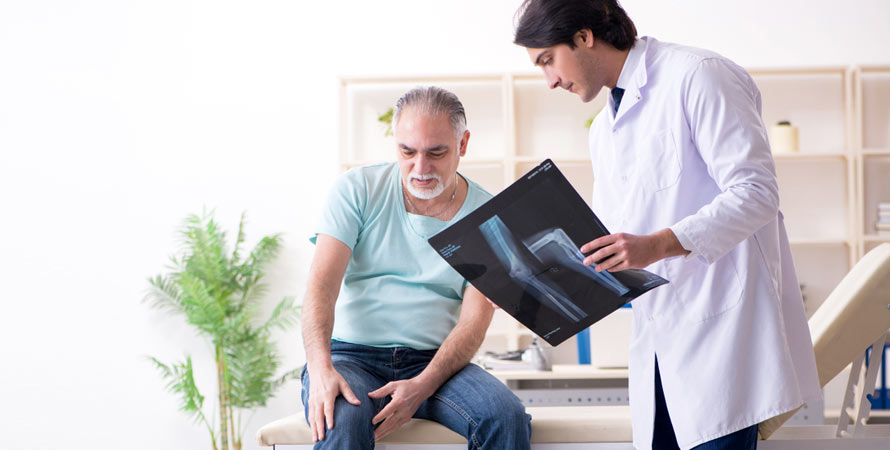Introduction
Joint effusion[1] occurs when too much synovial fluid builds up around the joint region. When this happens in the knee, it’s referred to as water on the knee or swollen knee. This can be the result of infection, injury, or a medical condition.
Knee joint effusion can be extremely painful and lead to prolonged discomfort. So, if you suffer or experience joint effusion, it’s a good idea to be well informed so that you can make better and more educated decisions regarding your treatment plan.
In this article, we’re going to take a look at the knee joint effusion causes, different available treatment options, and how people can use preventative measures to minimize the chances of it occurring.
Understanding Knee Joint Effusion

When you were younger, did you ever spend hot summer days filling up balloons with water? If so, do you remember how it felt when the balloons were tied? Superheavy with fluid, right?
This metaphor is similar to what occurs in our joints. When an injury transpires, it produces a fluid build-up that can begin to feel like a stiff water balloon. Knee joint effusion, more commonly referred to as water on the knee, happens when a surplus fluid begins to collect around the knee joint.
Joints are spaces where bones come together and meet, also known as articulations. When discussing knee joint effusion, the word “effusion” means an excessive fluid amount that collects within the articulation.
Normal joints contain synovial fluid, just in smaller amounts. Yet in certain cases, for example, arthritis, surplus fluid can collect, and the knee becomes swollen and puffy. Research[2] shows that 27% of people will experience joint effusion during their lifetimes, meaning that it’s not particularly rare.
The most common knee joint effusion causes are ligament injury, meniscus trauma, and arthritis.
What Causes Knee Joint Effusion?
Knee joint effusion[3] is commonly a sign of inflammation and can be classified as either noninfectious or infectious. Joint effusion produced by infection is known as septic arthritis, whereas an aseptic effusion is the result of injury or trauma.
1. Infection
One of the primary knee joint effusion causes, an infection can originate from a deep injury, wound, or a medical procedure. And in the case of a blood-based infection known as systemic infection, these can take hold in the joint region, causing excess fluid and swelling.
When an effusion is caused by infection, knee joint effusion symptoms are intense and worsen quickly. Specific conditions increase the risk of septic arthritis; some of these include diabetes, joint replacement surgery, arthritis, older age, and a weakened immune system.
2. Injury

Routine sports injuries are a common cause of knee joint effusion. Injuries incurred by other forms of accidents, such as a fall, blunt impact, or car accident, can also produce effusion. These injuries may involve ligaments, bones, tendons, or cartilage.
In individuals who have joint effusion from stress or repetitive injuries, such as when someone works out excessively, bursitis and tenosynovitis may also appear.
Common knee joint effusion symptoms, which are injury-related, include rotation difficulty, swelling, pain, and stiffness.
3. Arthritis
There are two kinds of arthritis:
Osteoarthritis – is also popularly referred to as “wear-and-tear” arthritis Autoimmune – such as rheumatoid arthritis, juvenile idiopathic arthritis, gout, and psoriatic arthritis, in which the immune system attacks joint regions
In cases of osteoarthritis, joint effusion predominantly affects the knee area and is most typically associated with joint damage. In autoimmune arthritis, joint effusion is most likely linked with acute flare-ups or chronic inflammation that originates as an immune response.
These immune responses are common in cases of autoimmunity and gout. The effusion is characterized and created by a collection of uric acid crystals in the joint space. Gout symptoms can appear quickly and severely, resulting in excessive synovial fluid in the joint area.
What Are The Symptoms Of Knee Joint Effusion?
The first symptom of knee joint effusion is the swelling of the knee region. This is tied to reduced and restricted mobility. The symptoms progress to cause pain and discomfort because the surplus synovial fluid within the knee produces significant pressure often felt behind the kneecap. A good way to judge the level of inflammation is by assessing the reddening, swelling, or heat coming from the knee.
Whatever the reason behind the fluid build-up, knee joint effusion symptoms tend to be similar, yet their severity will vary. Traditional symptoms of knee joint effusion[4] include:
- Stiffness – This limits a joint’s motion range or begins to restrict movement
- Swelling – This can range from mild discomfort to painful swelling
- Warmth and redness – These symptoms are commonly associated with inflammation
- Pain – The levels of pain can vary from a dull throbbing to an uncomfortable degree of pain that inhibits movement

Depending on the root cause of knee joint effusion, individuals may further experience the following symptoms as well:
- Malaise, chills, fever, and fatigue (infection is most likely present)
- Bleeding and bruising of the joint region (generated by an injury)
- Advanced muscle loss (this symptom stems from long-term arthritis, also referred to as atherogenic muscle inhibition)
A very commonly known complication of knee joint effusion is the appearance of a fluid-filled nodule within the joint space, more popularly referred to as a Baker’s cyst. This type of cyst occurs when the level of fluid build-up becomes excessive and cannot be absorbed or removed by the body naturally. Nevertheless, smaller Baker’s cysts do not cause symptoms or pain.
Knee Joint Effusion Treatment
The most commonly used knee joint effusion treatment includes ice application, rest, and the use of a nonsteroidal anti-inflammatory, such as Aleve or Advil.
If the swelling is severe, a healthcare professional may opt for draining the fluid as part of the knee joint effusion treatment option. They may also issue a cortisone injection after draining the fluid build-up. This methodology can quickly decrease inflammation and pain, particularly if the root cause of the joint effusion is arthritic damage or injury.
When an infection is the root cause of the knee joint effusion, it can be treated with broad antibiotics, such as Ciprofloxacin, for 14 days. More severe infections, like those produced by Staphylococcus aureus (MRSA), may need a four-week course of IV antibiotics.
When knee joint effusion arises in individuals with rheumatoid arthritis or autoimmune conditions, there are specific treatments steps people can take to get it under control. This intervention involves the application and use of immuno-suppressing drugs, like Humira. These drugs reduce an abnormal immune response and flare-ups.
In severe cases of knee joint effusion, an arthroplasty or joint surgery may be necessary to repair damaged tissue.
Most treatment protocols for knee joint effusion are dependent on the root cause, therefore treatment options will differ between individuals.
To summarize, knee joint effusion treatment includes the following:

- Drainage Or Aspiration – A medical professional uses a syringe to draw out the surplus synovial fluid, which can reduce pain
- Corticosteroid Injections – These can lessen inflammation and help soothe pain and discomfort
- Anti-inflammatory Drugs (NSAIDs) – These prescription NSAIDs can help with pain relief
- Antibiotics – These medications can treat an infection, should that be the underlying cause
- A Knee Brace – This option is usually considered for mild cases and can help to stabilize the joint
- DMARDS – These prescriptions are for long-term use and help manage immune conditions, such as rheumatoid arthritis
- Knee Replacement Or Knee Surgery – Surgery may be the treatment route in extremely severe cases
Frequently Asked Questions
Normally, knee injury recovery time lasts around 6 weeks. However, if surgery is required, the recovery time will increase and last anywhere between 8 weeks a year. The recovery time is dependent on many things, including the cause and severity of your effusion case.
An effusion is commonly the symptom of a condition or injury affecting the joint. In most cases, if the root cause is treated, the knee joint effusion will heal and go away. It's crucial to seek immediate medical attention if a joint effusion occurs for no reason or is paired with a high fever.
It's considered serious because it can be painful, especially when there is movement involved. And some cases of knee joint effusion, especially when paired with old-age or diabetes, can raise the risk of contracting septic arthritis.
Yes, the surplus synovial fluid build-up in the joint region can result in discomfort, stiffness, and pain.
Follow the advice outlined in this article and see your healthcare provider. Your doctor will assess your case and define a treatment protocol that will help get rid of your knee joint effusion.
Conclusion
Surplus fluid in the joint region is called an effusion, which affects more extensive joints such as the knee. A knee joint effusion occurs due to infection, injury, medical condition, or arthritis.
People find that after joint damage or serious injury, the knee will improve only to have fluid build-up again later. But, in most cases, the synovial fluid can be drained, and steps can be taken to address the root cause of the effusion.






